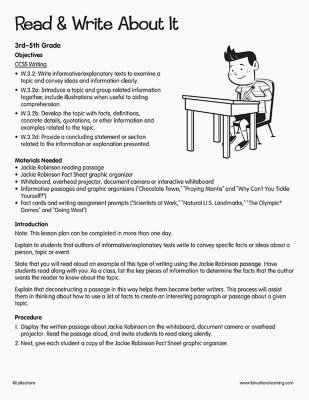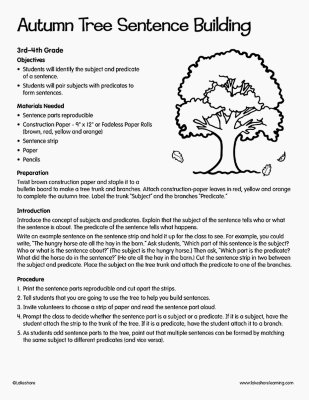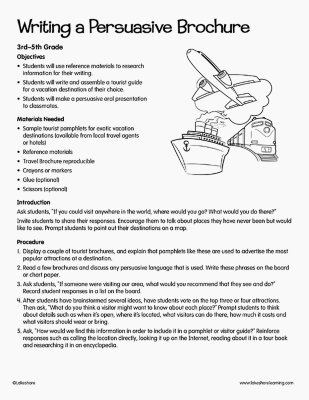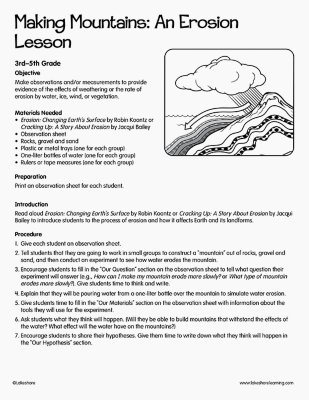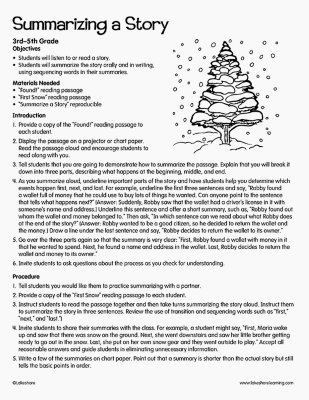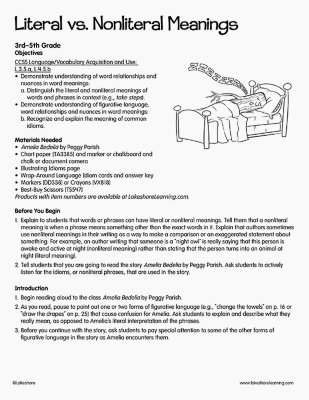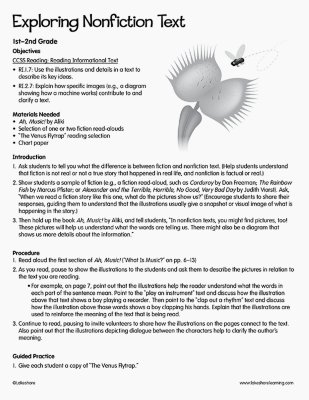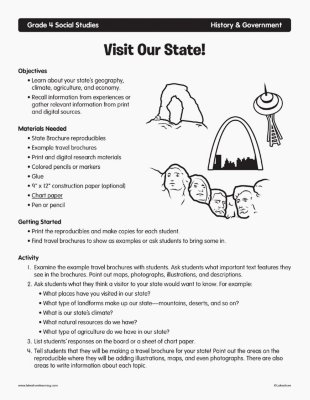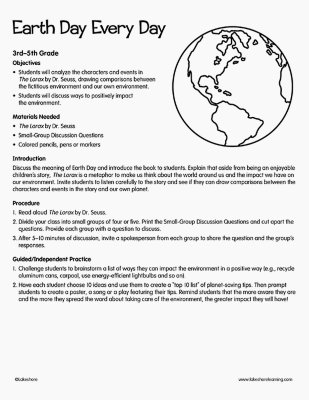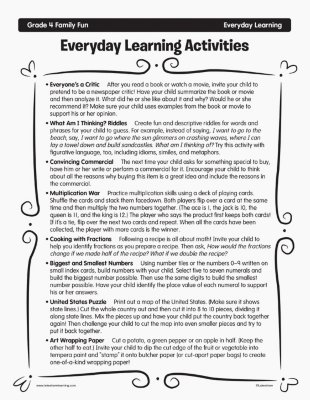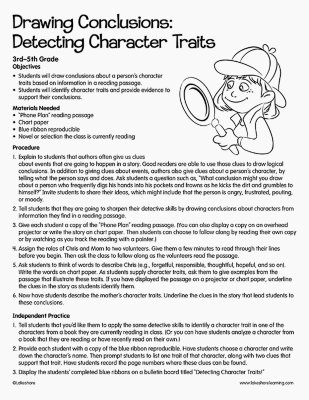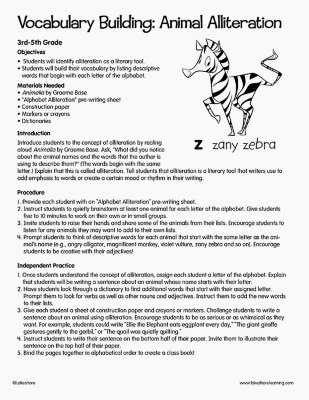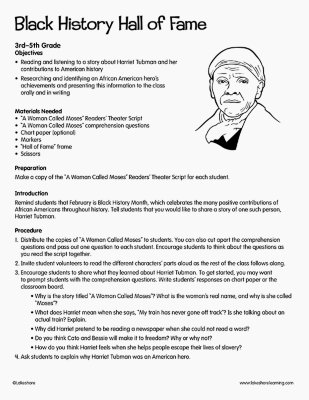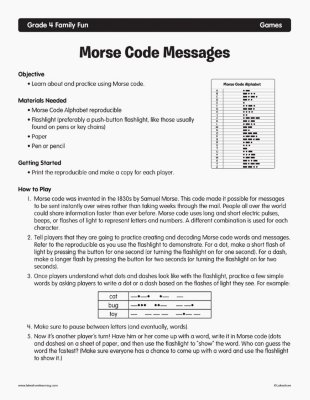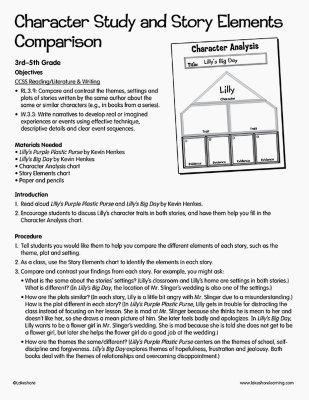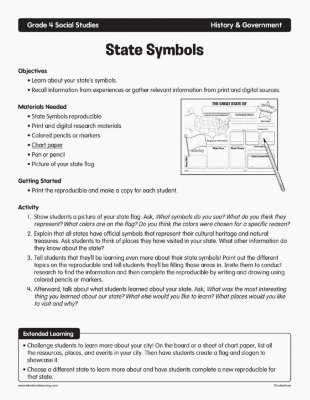Narrow by Grade
- Infant (0)
- Toddler (3)
- Preschool (0)
- Pre-K (12)
- Kindergarten (18)
- 1st (20)
- 2nd (14)
- 3rd (19)
- 4th (20)
- 5th (6)
- 6th & Up (0)
Grade 4th
Narrow by Age
- 0-18m (0)
- 18-36m (0)
- 3 yrs. (0)
- 4 yrs. (0)
- 5 yrs. (0)
- 6 yrs. (0)
- 7 yrs. (0)
- 8 yrs. (12)
- 9 yrs. (20)
- 10 yrs. (3)
- 11 yrs. & Up (0)
Age
20 results for "nuts about"
Filters
Clear All
Read & Write About It
3rd Grade - 4th Grade
Objectives CCSS Writing W.3.2: Write informative/explanatory texts to examine a topic and convey ideas and information clearly. W.3.2a: Introduce a topic and group related information together; include illustrations when useful to aiding comprehension. W.3.2b: Develop the topic with facts, definitions, concrete details, quotations, or other information and examples related to the topic. W.3.2d: Provide a concluding statement or section related to the information or explanation presented. Materials Needed Jackie Robinson reading passage Jackie Robinson Fact Sheet graphic organizer Whiteboard, overhead projector, document camera or interactive whiteboard Informative passages and graphic organizers (“Chocolate Town,” “Praying Mantis” and “Why Can’t You Tickle Yourself?”) Fact cards and writing assignment prompts (“Scientists at Work,” “Natural U.S. Landmarks,” “The Olympic® Games” and “Going West”) Introduction Note: This lesson plan can be completed in more than one day. Explain to students that authors of informative/explanatory texts write to convey specific facts or ideas about a person, topic or event. State that you will read aloud an example of this type of writing using the Jackie Robinson passage. Have students read along with you. As a class, list the key pieces of information to determine the facts that the author wants the reader to know about the topic. Explain that deconstructing a passage in this way helps them become better writers. This process will assist them in thinking about how to use a list of facts to create an interesting paragraph or passage about a given topic.
View Lesson PlanAutumn Tree Sentence Building
3rd Grade - 4th Grade
Objectives Students will identify the subject and predicate of a sentence. Students will pair subjects with predicates to form sentences. Materials Needed Sentence parts reproducible Construction Paper - 9" x 12" or Fadeless Paper Rolls (brown, red, yellow and orange) Sentence strip Paper Pencils Preparation: Twist brown construction paper and staple it to a bulletin board to make a tree trunk and branches. Attach construction-paper leaves in red, yellow and orange to complete the autumn tree. Label the trunk “Subject” and the branches “Predicate.” Introduction Introduce the concept of subjects and predicates. Explain that the subject of the sentence tells who or what the sentence is about. The predicate of the sentence tells what happens. Write an example sentence on the sentence strip and hold it up for the class to see. For example, you could write, “The hungry horse ate all the hay in the barn.” Ask students, “Which part of this sentence is the subject? Who or what is the sentence about?” (The subject is the hungry horse.) Then ask, “Which part is the predicate? What did the horse do in the sentence?” (He ate all the hay in the barn.) Cut the sentence strip in two between the subject and predicate. Place the subject on the tree trunk and attach the predicate to one of the branches.
View Lesson PlanWriting a Persuasive Brochure
3rd Grade - 5th Grade
Objectives Using reference materials to research for their writing Introducing the topic or text they are writing about, stating an opinion and creating an organizational structure that lists reasons Providing reasons that support the opinion Reporting on a topic or text, telling a story, or recounting an experience in an organized manner, using appropriate facts and relevant, descriptive details to support main ideas or themes; speaking clearly at an understandable pace Materials Needed Sample tourist pamphlets for exotic vacation destinations (available from local travel agents or hotels) Reference materials Travel Brochure reproducible Crayons or markers Glue (optional) Scissors (optional) Introduction Ask students, “If you could visit anywhere in the world, where would you go? What would you do there?” Invite students to share their responses. Encourage them to talk about places they have never been but would like to see. Prompt students to point out their destinations on a map.
View Lesson PlanMaking Mountains: An Erosion Lesson
4th Grade
Objective Make observations and/or measurements to provide evidence of the effects of weathering or the rate of erosion by water, ice, wind, or vegetation. Materials Needed Erosion: Changing Earth’s Surface by Robin Koontz or Cracking Up: A Story About Erosion by Jacqui Bailey Observation sheet Rocks, gravel and sand Plastic or metal trays (one for each group) One-liter bottles of water (one for each group) Rulers or tape measures (one for each group) Introduction Read aloud Erosion: Changing Earth’s Surface by Robin Koontz or Cracking Up: A Story About Erosion by Jacqui Bailey to introduce students to the process of erosion and how it affects Earth and its landforms.
View Lesson PlanSummarizing a Story
4th Grade
Objectives Students will listen to or read a story. Students will summarize the story in writing, using sequencing words in their summaries. Materials Needed “Found!” reading passage “First Snow” reading passage “Summarize a Story” reproducible Introduction Provide a copy of the “Found!” reading passage to each student. Display the passage on a projector or chart paper. Read the passage aloud and encourage students to read along with you. Tell students that you are going to demonstrate how to summarize the passage. Explain that you will break it down into three parts, describing what happens at the beginning, middle, and end. As you summarize aloud, underline important parts of the story and have students help you determine which events happen first, next, and last. For example, underline the first three sentences and say, “Robby found a wallet full of money that he could use to buy lots of things he wanted. Can anyone point to the sentence that tells what happens next?” (Answer: Suddenly, Robby saw that the wallet had a driver’s license in it with someone’s name and address.) Underline this sentence and offer a short summary, such as, “Robby found out whom the wallet and money belonged to.” Then ask, “In which sentence can we read about what Robby does at the end of the story?” (Answer: Robby wanted to be a good citizen, so he decided to return the wallet and the money.) Draw a line under the last sentence and say, “Robby decides to return the wallet to its owner.” Go over the three parts again so that the summary is very clear: “First, Robby found a wallet with money in it that he wanted to spend. Next, he found a name and address in the wallet. Last, Robby decides to return the wallet and money to its owner.” Invite students to ask questions about the process as you check for understanding.
View Lesson PlanLiteral vs. Nonliteral Meanings
3rd Grade - 4th Grade
Objective CCSS Language/Vocabulary Acquisition and Use: L.3.5.a, L.4.5.b Demonstrate understanding of word relationships and nuances in word meanings: a. Distinguish the literal and nonliteral meanings of words and phrases in context (e.g., take steps). Demonstrate understanding of figurative language, word relationships and nuances in word meanings: b. Recognize and explain the meaning of common idioms. Materials Needed Amelia Bedelia by Peggy Parish Chart paper and marker or chalkboard and chalk or document camera Illustrating Idioms page Wrap-Around Language Idiom cards and answer key Markers or Crayons Best-Buy Scissors Before You Begin Explain to students that words or phrases can have literal or nonliteral meanings. Tell them that a nonliteral meaning is when a phrase means something other than the exact words in it. Explain that authors sometimes use nonliteral meanings in their writing as a way to make a comparison or an exaggerated statement about something. For example, an author writing that someone is a “night owl” is really saying that this person is awake and active at night (nonliteral meaning) rather than stating that the person turns into an animal at night (literal meaning). Tell students that you are going to read the story Amelia Bedelia by Peggy Parish. Ask students to actively listen for the idioms, or nonliteral phrases, that are used in the story. Introduction Begin reading aloud to the class Amelia Bedelia by Peggy Parish. As you read, pause to point out one or two forms of figurative language (e.g., “change the towels” on p. 16 or “draw the drapes” on p. 25) that cause confusion for Amelia. Ask students to explain and describe what they really mean, as opposed to Amelia’s literal interpretation of the phrases. Before you continue with the story, ask students to pay special attention to some of the other forms of figurative language in the story as Amelia encounters them.
View Lesson PlanMenu Math
3rd Grade - 4th Grade
Objectives CCSS Math: Operations & Algebraic Thinking 3.OA.D.8: Solve two-step word problems using the four operations. Represent these problems using equations with a letter standing for the unknown quantity. Assess the reasonableness of answers using mental computation and estimation strategies including rounding. 4.OA.A.3: Solve multistep word problems posed with whole numbers and having whole-number answers using the four operations, including problems in which remainders must be
View Lesson PlanExploring Nonfiction Text
4th Grade
Objectives CCSS Reading: Reading Informational Text RI.1.7: Use the illustrations and details in a text to describe its key ideas. RI.2.7: Explain how specific images (e.g., a diagram showing how a machine works) contribute to and clarify a text. Materials Needed Ah, Music! by Aliki Selection of one or two fiction read-alouds “The Venus Flytrap” reading selection Chart paper Introduction Ask students to tell you what the difference is between fiction and nonfiction text. (Help students understand that fiction is not real or not a true story that happened in real life, and nonfiction is factual or real.) Show students a sample of fiction (e.g., a fiction read-aloud, such as Corduroy by Don Freeman; The Rainbow Fish by Marcus Pfister; or Alexander and the Terrible, Horrible, No Good, Very Bad Day by Judith Viorst). Ask, “When we read a fiction story like this one, what do the pictures show us?” (Encourage students to share their responses, guiding them to understand that the illustrations usually give a snapshot or visual image of what is happening in the story.) Then hold up the book Ah, Music! by Aliki, and tell students, “In nonfiction texts, you might find pictures, too! These pictures will help us understand what the words are telling us. There might also be a diagram that shows us more details about the information.”
View Lesson PlanMy Awesome, Amazing, Very Good, Super-Great Day Story
3rd Grade - 4th Grade
Objectives Students will listen to, recall and interpret information from literature. Students will make connections to their personal experiences. Students will write a descriptive paragraph. Materials Needed Alexander and the Terrible, Horrible, No Good, Very Bad Day by Judith Viorst Graphic organizer Revising and Editing checklist Introduction Read aloud Alexander and the Terrible, Horrible, No Good, Very Bad Day to your class. After you read, ask students to recall the things that happened to Alexander that added to his terrible, horrible, no good, very bad day. Then ask students to think about what could have happened differently to turn Alexander’s day into an awesome, amazing, very good, super-great day. Invite volunteers to share their responses.
View Lesson PlanVisit Our State!
4th Grade
Objectives
- Learn about your state’s geography, climate, agriculture, and economy.
- Recall information from experiences or gather relevant information from print and digital sources.
Earth Day Every Day
3rd Grade - 5th Grade
Objectives Students will analyze the characters and events in The Lorax by Dr. Seuss, drawing comparisons between the fictitious environment and our own environment. Students will discuss ways to positively impact the environment. Materials Needed The Lorax by Dr. Seuss Small-Group Discussion Questions Colored pencils, pens or markers Introduction Discuss the meaning of Earth Day, and introduce the book to students. Explain that aside from being an enjoyable children’s story, The Lorax is a metaphor to make us think about the world around us and the impact we have on our environment. Invite students to listen carefully to the story and see if they can draw comparisons between the characters and events in the story and our own planet.
View Lesson PlanEveryday Learning Activities
4th Grade
Everyone’s a Critic After you read a book or watch a movie, invite your child to pretend to be a newspaper critic! Have your child summarize the book or movie and then analyze it. What did he or she like about it and why? Would he or she recommend it? Make sure your child uses examples from the book or movie to support his or her opinion.
View Lesson PlanState History
4th Grade
Objectives
- Learn about your state’s history.
- Recall information from experiences or gather relevant information from print and digital sources.
- Conduct a short research project that builds knowledge through the investigation of different aspects of a topic.
Drawing Conclusions: Detecting Character Traits
3rd Grade - 4th Grade
Objectives Students will draw conclusions about a person’s character traits based on information in a reading passage. Students will identify character traits and provide evidence to support their conclusions. Materials Needed “Phone Plan” reading passage Chart paper Blue ribbon reproducible Novel or selection the class is currently reading
View Lesson PlanVocabulary Building: Animal Alliteration
3rd Grade - 4th Grade
Objectives Students will identify alliteration as a literary tool. Students will build their vocabulary by listing descriptive words that begin with each letter of the alphabet. Materials Needed Animalia by Graeme Base “Alphabet Alliteration” pre-writing sheet Construction paper Markers or crayons Dictionaries Introduction Introduce students to the concept of alliteration by realing aloud Animalia by Graeme Base. Ask, “What did you notice about the animal names and the words that the author is using to describe them?” (The words begin with the same letter.) Explain that this is called alliteration. Tell students that alliteration is a literary tool that writers use to add emphasis to words or create a certain mood or rhythm in their writing.
View Lesson PlanBlack History Hall of Fame
3rd Grade - 5th Grade
Objectives Reading and listening to a story about Harriet Tubman and her contributions to American history Researching and identifying an African American hero’s achievements and presenting this information to the class orally and in writing Materials Needed “A Woman Called Moses” Readers’ Theater Script “A Woman Called Moses” comprehension questions Chart paper (optional) Markers “Hall of Fame” frame Scissors Preparation Make a copy of the “A Woman Called Moses” Readers’ Theater Script for each student. Introduction Remind students that February is Black History Month, which celebrates the many positive contributions of African Americans throughout history. Tell students that you would like to share a story of one such person, Harriet Tubman.
View Lesson PlanCharacter Study and Story Elements Comparison
3rd Grade - 4th Grade
Objectives CCSS Reading/Literature & Writing RL.3.9: Compare and contrast the themes, settings and plots of stories written by the same author about the same or similar characters (e.g., in books from a series). W.3.3: Write narratives to develop real or imagined experiences or events using effective technique, descriptive details and clear event sequences. Materials Needed Lilly’s Purple Plastic Purse by Kevin Henkes Lilly’s Big Day by Kevin Henkes Character Analysis chart Story Elements chart Paper and pencils Introduction Read aloud Lilly’s Purple Plastic Purse and Lilly’s Big Day by Kevin Henkes. Encourage students to discuss Lilly’s character traits in both stories, and have them help you fill in the Character Analysis chart.
View Lesson PlanState Symbols
4th Grade
Objectives
- Learn about your state’s symbols.
- Recall information from experiences or gather relevant information from print and digital sources.
Close Reading and Text Features
3rd Grade - 4th Grade
Objectives CCSS Reading: Informational Text RI.3.7: Use information gained from illustrations (e.g., maps, photographs) and the words in a text to demonstrate understanding of the text (e.g., where, when, why, and how key events occur). RI.4.7: Interpret information presented visually, orally, or quantitatively (e.g., in charts, graphs, diagrams, time lines, animations, or interactive elements on Web pages) and explain how the information contributes to an understanding of the text in which it appears. Materials Needed “Three Cheers for Engineers!” reading passage Paper and pencils Introduction Provide students with a copy of the “Three Cheers for Engineers!” reading passage. Tell students, “Today we are going to read a passage titled, “Three Cheers for Engineers!” One practice of good readers is that they pay close attention to the text. As we read, I want you to think about the meaning of the text, the words that are used and other features on the page that are used to help interpret the text.”
View Lesson Plan